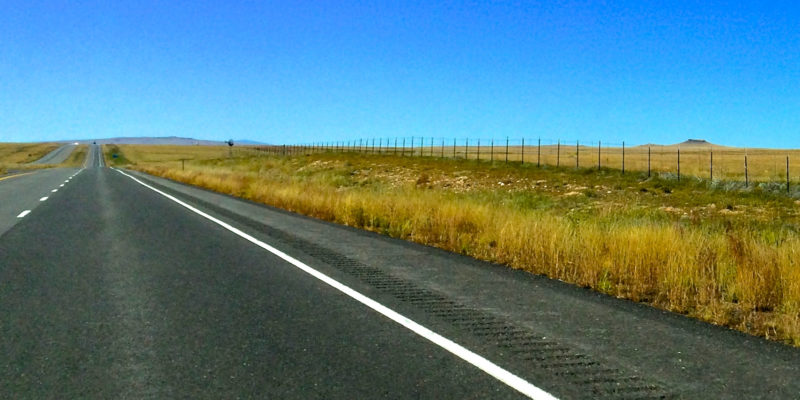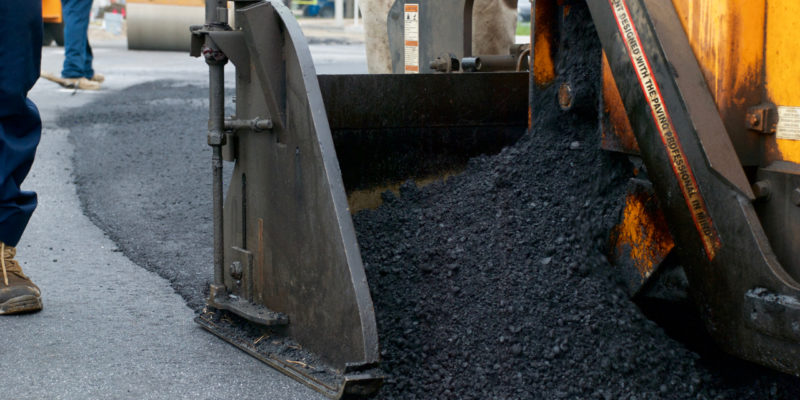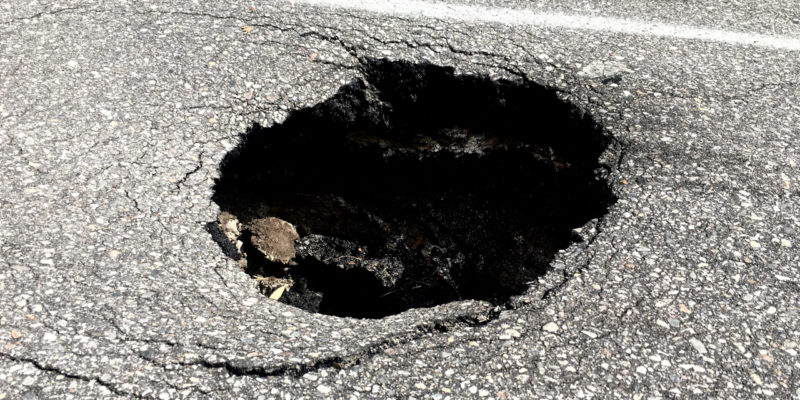Wondering what are roads made of may have only been a fleeting thought you pondered one day while waiting for the “Walk” signal at a crosswalk, but a thorough answer requires traveling way back through antiquity to look at where roads first came from before we examine the roads of modern day.
The first roads appeared in the Stone Age to facilitate the need of transporting goods when primitive humans discovered that using pack animals like donkeys and horses were more efficient than using their heads. A travois is a frame developed to be used on roads in Eurasia that is believed to be the first vehicle. In about 5000 BC, sleds developed, which are more harder to build than travois, but are easier to guide over smooth surfaces, thus necessitating smoother roads. As a result, by about 5000 BC roads, including the Ridgeway, developed along ridges in England to avoid getting stuck while crossing rivers. In central Germany, such ridgeways remained the predominant form of long-distance road till the mid 18th century.
This leads to perhaps the most important human technological advancement of all time, the wheel, which appears to have been created in ancient Sumer in Mesopotamia around 5000 BC. It is believed they were used to help reduce the resistance of the ground by being attached under sleds. Some say logs were first used under sleds but as of now there is no archaeological evidence to support this fact. It has been observed that most early wheels appear to have been attached to fixed axles, which would have required regular lubrication to be effective, perhaps by vegetable oil, leather, or animal fats. Roads needed to evolve from cleared dirt to serve this new dependence on wheeled vehicles.
The first roads were made of stone and developed in urban areas in Ur in 4000 BC. Advancements in stone cutting made cutting tools more widely available in the Middle East and Greece, where local roads were paved. The best road of the time was constructed by the Minoans that extended 50 km from Knossos in north Crete through the mountains to the port town of Labena that had side drainage and a 200 mm thick pavement made of sandstone blocks bound with clay gypsum mortar that was covered by a layer of basaltic flagstones. This road was a precursor to modern roads with it’s shoulders.
Asphalt
What are roads made of today? We’ve made some leaps since the times of the Romans. Modern roads went from gravel to cobblestone and granite to asphalt and concrete poured over a compacted base course. Asphalt is sometimes called flexible pavement due to the way it distributes loads and its been widely used since the 1920s. “The viscous nature of the bitumen binder allows asphalt concrete to sustain significant plastic deformation, although fatigue from repeated loading over time is the most common failure mechanism. Most asphalt surfaces are laid on a gravel base, which is generally at least as thick as the asphalt layer, although some ‘full depth’ asphalt surfaces are laid directly on the native subgrade. In areas with very soft or expansive subgrades such as clay or peat, thick gravel bases or stabilization of the subgrade with Portland cement or lime may be required. Polypropylene and polyester geosynthetics have also been used for this purpose[1] and in some northern countries, a layer of polystyrene boards have been used to delay and minimize frost penetration into the subgrade.[2]” Depending on the temperature at which it is applied, asphalt is categorized as hot mix, warm mix, or cold mix. Hot mix asphalt is applied at temperatures over 300 °F (150 °C) with a free floating screed. Warm mix asphalt is applied at temperatures of 200–250 °F (95–120 °C), resulting in reduced energy usage and emissions of volatile organic compounds.[3] Cold mix asphalt is often used on lower-volume rural roads, where hot mix asphalt would cool too much on the long trip from the asphalt plant to the construction site.[4]
An asphalt concrete surface will generally be constructed for high-volume primary highways having an average annual daily traffic load greater than 1200 vehicles per day.[5] Advantages of asphalt roadways include relatively low noise, relatively low cost compared with other paving methods, and perceived ease of repair. Disadvantages include less durability than other paving methods, less tensile strength than concrete, the tendency to become slick and soft in hot weather and a certain amount of hydrocarbon pollution to soil and groundwater or waterways.
In the mid-1960s, rubberized asphalt was used for the first time, mixing crumb rubber from used tires with asphalt. While a potential use for tires that would otherwise fill landfills and present a fire hazard, rubberized asphalt has shown greater incidence of wear in freeze-thaw cycles in temperate zones due to non-homogeneous expansion and contraction with non-rubber components. Also, application of rubberized asphalt is more temperature-sensitive, and in many locations can only be applied at certain times of the year.
When it comes to long term acoustic benefits of rubberized asphalt, the results are inconclusive. Initial application of rubberized asphalt may provide 3–5 decibels (dB) reduction in tire-pavement source noise emissions; however, this translates to only 1–3 decibels (dB) in total traffic noise level reduction (due to the other components of traffic noise). Compared to traditional passive attenuating measures (e.g., noise walls and earth berms), rubberized asphalt provides shorter-lasting and lesser acoustic benefits at typically much greater expense.
Concrete
Concrete surfaces are created using a concrete mix of Portland cement, coarse aggregate, sand and water. In virtually all modern mixes there will also be various admixtures added to increase workability, reduce the required amount of water, mitigate harmful chemical reactions and color. In many cases there will also be Portland cement substitutes added, such as fly ash. This can reduce the cost of the concrete and improve its physical properties. The material is applied in a freshly mixed slurry, and worked mechanically to compact the interior and force some of the cement slurry to the surface to produce a smoother, denser surface free from honeycombing. The water allows the mix to combine molecularly in a chemical reaction called hydration.
Concrete surfaces have been refined into three common types: jointed plain (JPCP), jointed reinforced (JRCP) and continuously reinforced (CRCP). The one item that distinguishes each type is the jointing system used to control crack development.
- Jointed plain concrete pavements contain enough joints to control the location of all the expected shrinkage cracks. The concrete cracks at the joints and not elsewhere in the slabs. Jointed plain pavements do not contain any steel reinforcement. However, there may be smooth steel bars at transverse joints and deformed steel bars at longitudinal joints. The spacing between transverse joints is typically about 15 feet (4.6 m) for slabs 7 to 12 inches (180 to 300 mm) thick. Today, a majority of US state agencies build jointed plain pavements.
- Jointed reinforced concrete pavements contain steel mesh reinforcement (sometimes called distributed steel). In jointed reinforced concrete pavements, designers increase the joint spacing purposely, and include reinforcing steel to hold together intermediate cracks in each slab. The spacing between transverse joints is typically 30 feet (9.1 m) or more. In the past, some agencies used a spacing as great as 100 feet (30 m). During construction of the interstate system, most agencies in the Eastern and Midwestern United States laid jointed-reinforced pavement. Today only a handful of agencies employ this design, and its use is generally not recommended by professional contractors as both of the other types offer better performance and are easier to repair.
- Continuously reinforced concrete pavements do not require any transverse contraction joints. Transverse cracks are expected in the slab, usually at intervals of 3 to 5 ft (0.91 to 1.52 m). These pavements are designed with enough steel, 0.6–0.7% by cross-sectional area, so that cracks are held together tightly. Determining an appropriate spacing between the cracks is part of the design process for this type of pavement.
Continuously reinforced designs may cost slightly more than jointed reinforced or jointed plain designs due to increased quantities of steel. Often the cost of the steel is offset by the reduced cost of concrete because a continuously reinforced design is nearly always significantly thinner than a jointed design for the same traffic loads. Properly designed, the two methods should demonstrate similar long-term performance and cost-effectiveness. A number of agencies have made policy decisions to use continuously reinforced designs in their heavy urban traffic corridors.
One of the major advantages of concrete pavements is they are typically stronger and more durable than asphalt roadways. They also can be grooved to provide a durable skid-resistant surface. A notable disadvantage is that they typically can have a higher initial cost, and can be more time-consuming to construct. This cost can typically be offset through the long life cycle of the pavement. Concrete pavement can be maintained over time utilizing a series of methods known as concrete pavement restoration which include diamond grinding, dowel bar retrofits, joint and crack sealing, cross-stitching, etc. Diamond grinding is also useful in reducing noise and restoring skid resistance in older concrete pavement.[7][8]
A little bit of trivia, the first street in the United States to be paved with concrete was Court Avenue in Bellefontaine, Ohio in 1893. The first mile of concrete pavement in the United States was on Woodward Avenue in Detroit, Michigan in 1909.



